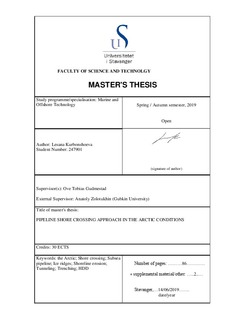| dc.contributor.advisor | Gudmestad, Ove Tobias | |
| dc.contributor.author | Kurbonshoeva, Lesana | |
| dc.coverage.spatial | Arctic region | nb_NO |
| dc.date.accessioned | 2019-10-09T08:13:30Z | |
| dc.date.available | 2019-10-09T08:13:30Z | |
| dc.date.issued | 2019-06-14 | |
| dc.identifier.uri | http://hdl.handle.net/11250/2621076 | |
| dc.description | Master's thesis in Offshore Technology : Subsea technology | nb_NO |
| dc.description.abstract | The energy demand will increase the development of new offshore areas including the Arctic region. The construction of new infrastructure will be required in the region, in particular, subsea pipelines. Considering the lack of much practice, vulnerability of the ecosystem and lack of common international standards for the Arctic region, their development will be a technological and environmental challenge. In particular, in the transition zones.
Master thesis ambitions to analyze the characteristics of the design of the offshore pipelines on the coastline in the Arctic.
Several Arctic projects with the shore crossing transitions exist nowadays, such as Northstar, Ooguruk and Nikaitchuq in the Beaufort Sea developed under the trenching method. Two additional projects – Sakhalin 1 and Bovanenkovo-Ukhta – were also reviewed as part of the thesis. Another project located not in the Arctic that was considered is the Langeled pipeline from Norway to UK.
There are exist three possible methods: trenching; tunneling and Horizontal Directional Drilling (HDD). All of these methods have advantages and disadvantages mainly related to the environmental conditions cost implications.
The Arctic region re-emphasizes the critical role of the environmental conditions on the selection of the right crossing methods:
- Ice encroachment increases the stress on the infrastructure and can damage the shore infrastructure and artificial gravel pads can be used to minimize their impact.
- Ice ridges tend to scour the sea bottom and damage the subsea pipeline. To protect the pipeline from ice ridges it is recommended to bury it.
- Shoreline erosion can be the cause of pipeline stability loss.
These implications are illustrated with a practical case on Leningradskoe field. Firstly environmental conditions such as the characteristics of the shore and offshore geology or the shoreline erosion rate were determined to confirm that the region is located in harsh environment.
Reviewing the environmental conditions led to conclude that the tunneling method is the recommended shore crossing approach for Leningradskoye Field due to high cliff, unstable soil, presence of constant permafrost and fragile ecosystem.
The shield penetration method is recommended to be applied to lay the pipeline the tunnel. To pull the pipeline in tunnel pulling force is calculated by applying Russian Set of Rules (Russian «Свод Правил») 42-101-2003 General provisions for the design and construction of gas distribution systems of metal and polyethylene pipes.
Comparative analysis with the 5 projects in the Beaufort and Russian offshore as well as the Langeled pipeline through 4 parameters was performed. The analysis showed the most compatibility with Langeled project and Bovanenkovo-Ukhta in the Russian offshore.
The final aspect of design was the protection of pipe from ice ridges. Above mentioned Force model was used to calculate the recommended burial depth that tend to be 3.52 m.
To sum up, the microtunneling method was recommended to be used for the Leningradskoye field in combination with a cofferdam corridor to protect from waves and buried pipe in the nearshore area. To estimate possible negative environmental impact and risks the detailed risk analysis was performed. Using the risk matrix the key possible negative risks were determined and reduction measures were introduced in the work.
Therefore on the basis of environmental conditions study and conducted practical case the basic choice making diagram was established in order to determine the best method for certain arctic region. | nb_NO |
| dc.language.iso | eng | nb_NO |
| dc.publisher | University of Stavanger, Norway | nb_NO |
| dc.relation.ispartofseries | Masteroppgave/UIS-TN-IMBM/2019; | |
| dc.subject | offshore teknologi | nb_NO |
| dc.subject | undervannsteknologi | nb_NO |
| dc.subject | the Arctic | nb_NO |
| dc.subject | shore crossing | nb_NO |
| dc.subject | subsea pipeline | nb_NO |
| dc.subject | ice ridges | nb_NO |
| dc.subject | shoreline erosion | nb_NO |
| dc.subject | Arktis | nb_NO |
| dc.title | Pipeline Shore Crossing Approach in the Arctic Conditions | nb_NO |
| dc.type | Master thesis | nb_NO |
| dc.subject.nsi | VDP::Technology: 500::Marine technology: 580::Offshore technology: 581 | nb_NO |
